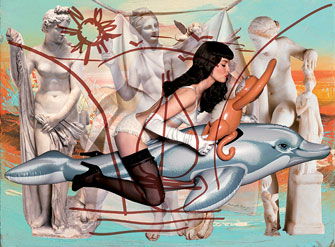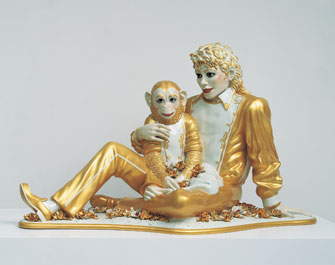Art as Commodity and
The Craft of Self-Promotion
 “Antiquity 3” (2009-11). Photo: Tom Powel Imaging. © Jeff Koons.
“Antiquity 3” (2009-11). Photo: Tom Powel Imaging. © Jeff Koons.
If you, like many people, are bemused by Jeff Koons, now is your chance to see some of his most celebrated artworks firsthand. According to Bernard Blistène, French co-curator of the Jeff Koons retrospective at the Centre Pompidou, the designers of the show wanted to “give the public a chance to see the artworks in an up-front and personal way, so people can make up their own minds” about the controversial superstar artist. It is certainly the case that, while Koons’ iconic pieces are well known through the media, until now few of these works, many of which have been loaned by private collectors, have been available for close inspection.
The paradox of Koons’ œuvre is that, while he has spent a lifetime mocking tradition and offering an ironic, subversive and frequently shocking interpretation of art, including ready-made and apparently kitschy or trashy objects, the creations are today worth millions and are avidly sought by wealthy collectors around the world. As such, the exhibition addresses core questions about perceptions, value and quality.
This quintessentially American figure, the scion of an affluent Philadelphian merchant family, is undoubtedly an artist in the craft of self-promotion. Modesty is not a word with which he could ever be associated. We learn that in the 1980s, besides his art creations, he was making a living as a commodities and funds trader in New York’s finance hub.
Rejecting any intellectual dialectic, he declares: “My work is anti-critical. It represents a fight against the critical function as a necessity of art. I am aiming to abolish any form of judgment, so that you can look at the world and accept it in its totality.”
Early work involved the display of ready-made objects, such as Hoover vacuum cleaners, encased in transparent Perspex boxes, an American take on Dada iconography, whose inventor, Marcel Duchamp, is currently the subject of another exhibition at the Centre Pompidou, offering visitors a potentially intriguing double visit. The legendary Surrealist may be spinning in his grave, however, as his noisy neighbor upstairs must represent all he detested about the emerging multimillion-dollar art market.
A recent feature on Koons in Vanity Fair magazine explains how as a young man bewitched with the idea of joining the avant-garde, he got a job on the membership desk at the Museum of Modern Art in New York, where he made a mark with his “eye-catching outfits and attention-getting accessories.” It proved to be the start of a career through which he has shown a virtuoso ability to win over the art establishment.
In recent years, Koons has been talking about the search for perfection as his main impulse. He speaks of striving toward a “pure surface,” and it is apparent that his art has become an industry in which the works benefit from a high level of craftsmanship. At least 120 technicians and assistants are employed at his studio in the Chelsea neighborhood of New York.
The remarkably kitsch “Banality” series involved a partnership with top European craftsmen: “Michael Jackson and Bubbles”

“Michael Jackson and Bubbles” (1988). Photo: Douglas M. Parker Studios, Los Angeles. © Jeff Koons
was actually made in a specialist Italian ceramics workshop. This figure is notable for the grotesque costume and awful appearance of the singer’s face.
On show among the “Celebration” series is the ostentatious “Balloon Dog,” an almost 4-meter-high object made of highly polished
.jpg)
“Balloon Dog (Magenta)” (1994-2000). © Jeff Koons. Photo © Jeff Koons
chrome in the form of sausage-shaped balloons, which are actually cast in stainless steel. Five of them were made, one of which was recently sold for $58 million, a record price for a work by a living artist.
The Koons studio in New York houses a gym where the unashamedly vain artist can work out, projecting his own body as an essential feature of the œuvre. In the early 1990s, his relationship with the Italian porn actress Cicciolina led to the series called “Made in Heaven,” featuring giant, lurid pictures of her and Koons taking part in sex acts. There is also a model of the couple making love, beautifully made in purple Italian glass (“Violet-Ice [Kama Sutra],” 1991). Was this inspired by Marcel Duchamp, who portrayed himself playing chess with a nude model in an exhibition in Pasadena, in 1962? Duchamp’s performance at the chess board must have been known to Koons, who has ventured much further into the realms of desire and sex in art, but we will never know whether Duchamp’s work influenced that of Koons since the latter never justifies his work.
Close observers of the Koons approach, like Blistène, who is the director of the Musée de l’Art Moderne in Paris, note that the artist is becoming ever-more obsessed with detail in these “faux-luxurious” objects, which are earning astronomical sums at art auctions.
When we reach his most recent and elaborate artifacts, in the “Antiquity” series, the extreme attention paid to shiny perfection is evident. “Metallic Venus” (2010-12) and “Pluto and Proserpina” (2010), heavy, dazzling chrome-effect statues adorned with fresh flowers, are the products of highly sophisticated technologies involving scanners, high-tech metal casting and ultramodern color-application techniques.
But why is Koons making a copy of a somewhat ordinary sculpture representing a poor little girl adorning a cheap music box? Even an art connoisseur struggles to find meaning. “I am still having difficulty understanding what Koons means,” Blistène tells us: “Ca me laisse pantois…” (“I’m dumbfounded”). Could it be taken as mockery of the wealthy art collectors who now proudly show off their Koons pieces amid luxurious private surroundings? The statues were cast by the Koons team from plaster copies kept at the Louvre. “They were not perfect enough,” the artist apparently complained.
In “Liberty Bell” (2006), the aim was to produce an exact visual replica of Philadelphia’s historic cracked bell. The methods used in its making reached an obsessional level of analysis and embellishment. The process took eight years and involved a partnership with a specialist foundry in Germany.
The exorbitant manufacturing cost and glossy final appearance of the latest Koons productions will stimulate reflection on questions relating to worth, perceived value and the venerable conundrum concerning the significance of art, craft and taste. If there is any truth in the age-old saying “Money shouts, wealth whispers,” the proud owner of “Balloon Dog” must by now be stone deaf.
Centre Pompidou: 19, rue Beaubourg, 75004 Paris. Tel.: 01 44 78 12 33. Open 11am-9pm. Closed Tuesday. Métro: Rambuteau. Admission: €11-13. Through April 27, 2015. www.centrepompidou.fr
Click here to read all of this week’s new articles on the Paris Update home page.
Reader Michael Barker writes: “One can only wonder if the kitsch works of Jeff Koons will still be fetching exorbitant prices in, say, 20 years’ time.“
Reader Richard Ewen writes: “When I was studying in the early ’60s, I was belatedly exposed to Pop Art, which countered all the traditional teachings of all but one of the art faculty. I couldn’t get my head around ‘happenings’ and Oldenburg’s large soft sculptures. By the time I graduated from Cranbrook Academy of Art in 1971, I couldn’t get enough of Rauschenberg, Johns and Oldenburg. I’m too far along in my career to be influenced by today’s younger artists, and I leave it to them to sort out the value of Koons’s work. It’s just too much, like Hollywood, but bigger and much more expensive.”
Reader Reaction: Click here to respond to this article (your response may be published on this page and is subject to editing).
Support Paris Update by ordering books from Paris Update’s Amazon store at no extra cost. Click on your preferred Amazon location: U.K., France, U.S.
© 2014 Paris Update
Favorite